
What’s the difference between Augmented (AR), Virtual (VR), Mixed (MR) and Extended Reality (XR)
In this article, we’ll dive deep into explaining the differences between and applications for Augmented (AR), Virtual (VR), Mixed (MR) and Extended Reality (XR).
From the early days of rudimentary virtual simulations to today’s lifelike digital integrations, the journey of immersive tech has been nothing short of revolutionary.
But what exactly are those “technologies”? Immersive tech can be categorised into three larger groups: Augmented Reality (AR), Virtual Reality (VR), Mixed Reality (MR). Collectively they make up yet an extra term – Extended Reality (XR). XR is a relatively new concept but it has already transformed the way we interact with both the digital and physical worlds.
Understanding the nuances and distinctions between AR, VR, MR, and XR is more than just a matter of semantics. Each offers a unique experience and has specific applications across industries, from entertainment and gaming to healthcare and education. As these technologies continue to evolve and shape our future, grasping their individual characteristics and potential applications becomes crucial for innovators, businesses, and consumers alike.
Of course, all these immersive experiences are built using 3D models, so if you’d like to give a go on creating your own, then Alpha3D AI 3D Model Generator is a good starting point.
The Virtuality Continuum
At the heart of understanding immersive technologies lies the concept of the Virtuality Continuum. This continuum represents a spectrum that spans from a wholly real environment to an entirely virtual one. Imagine a sliding scale: on one end, you have the real world as we know it, untouched by digital influence. As you slide towards the other end, digital elements begin to overlay and then completely replace the real world until you’re immersed in a fully virtual space.
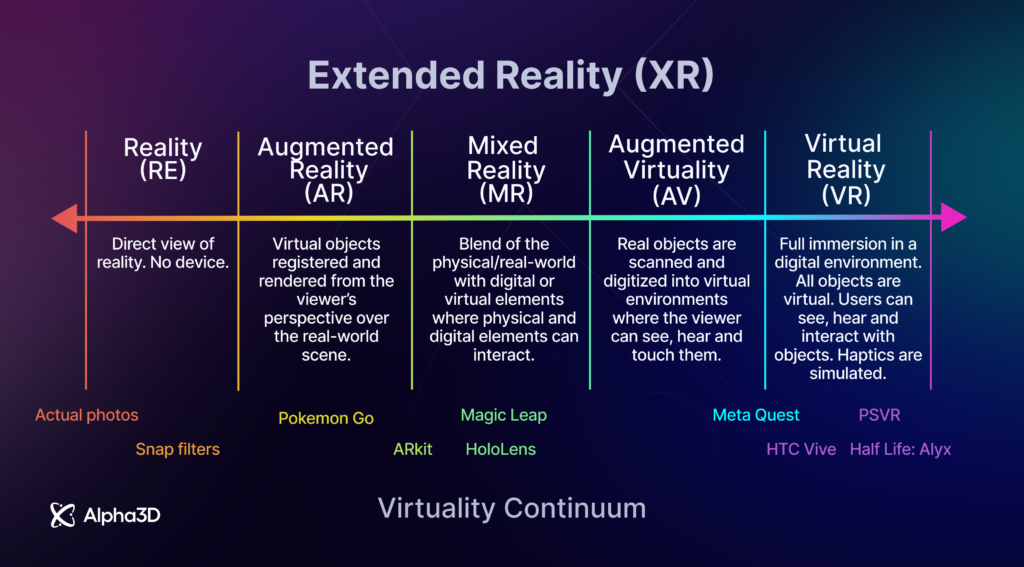
The relevance of the Virtuality Continuum becomes evident when we start categorizing different immersive experiences. For instance, Augmented Reality (AR) resides closer to the real-world end of the spectrum, where digital elements are merely superimposed onto our physical surroundings. In contrast, Virtual Reality (VR) sits at the opposite end, offering a fully digital environment that detaches users from the real world.
Mixed Reality (MR) occupies a unique space in the middle, merging the real and virtual to such an extent that digital and physical objects can interact in real-time. Extended Reality (XR) serves as an umbrella term that encompasses the entire spectrum, highlighting the seamless merge of real and virtual environments.
Augmented Reality (AR)
Augmented Reality (AR) is a technology that superimposes digital information, such as images, videos, or sounds, onto the real world. Unlike Virtual Reality, which creates a wholly artificial environment, AR integrates and overlays virtual data on real-world scenes in real-time.
The magic of AR lies in its ability to bridge the digital and physical realms. By using devices like smartphones, tablets, or specialized AR glasses, users can see the real world around them with an added layer of digital content. This content can be as simple as static images or as complex as interactive 3D models.
One of the most iconic examples of AR in action is the mobile game Pokémon Go. Players use their smartphones to find and capture virtual creatures called Pokémon, which appear as if they’re in the player’s real-world location. The game became a global phenomenon, showcasing the potential of AR to create engaging and interactive experiences.
In terms of devices and technologies, AR has seen significant advancements. While smartphones and tablets remain popular for AR applications due to their accessibility, specialized devices like the Microsoft HoloLens or Magic Leap One offer more advanced and immersive AR experiences. These devices, often referred to as smart glasses or AR glasses, overlay high-definition holograms onto the user’s view, allowing for more intricate interactions with digital content.
Virtual Reality (VR)
Virtual Reality (VR) is a digital experience that immerses users in a simulated environment. Unlike AR, which augments the real world with digital elements, VR replaces the real world entirely, transporting users to a virtual space created by computer graphics.
The essence of VR lies in its ability to create a sense of presence. When users don a VR headset, they’re not just observing a digital world; they’re immersed in it. This immersion can be so profound that users often feel as if they’re truly “inside” the virtual environment, experiencing it firsthand.
VR experiences can vary in their level of immersion. As we move up the immersion scale, we encounter room-scale VR, where users can physically move within a limited space, and their movements are mirrored in the virtual world. The pinnacle of VR immersion is fully-immersive VR, where users are completely engrossed in the virtual environment, often with the aid of motion controllers and external sensors.
Several devices have become synonymous with high-quality VR experiences. The HTC Vive offers precise tracking and a vast library of VR content. The Meta Quest is a standalone VR headset that doesn’t require a PC, making VR more accessible to a broader audience.
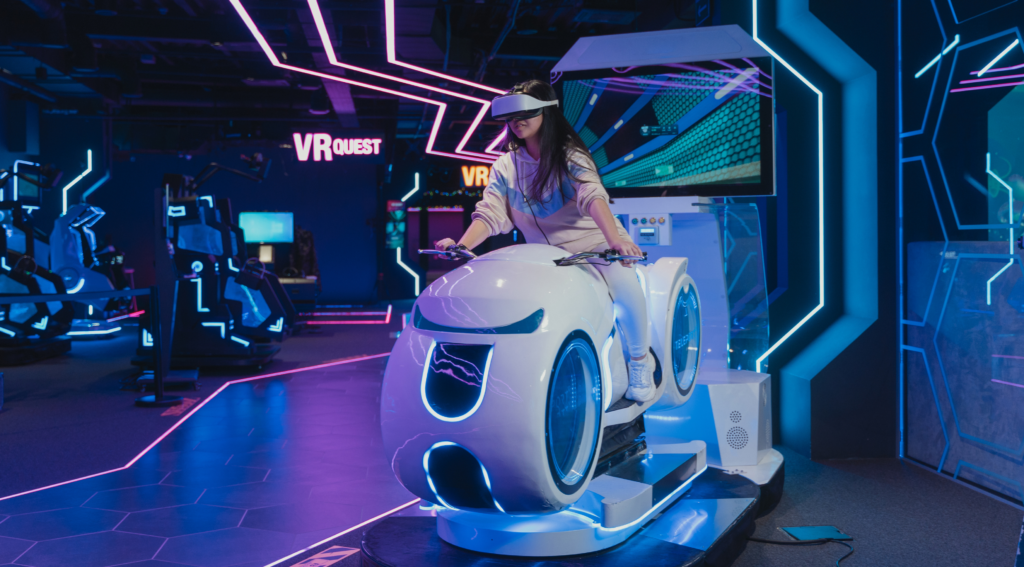
Mixed Reality (MR)
Mixed Reality (MR) stands at the intersection of the real and virtual worlds, blending elements from both to produce new environments where physical and digital objects co-exist and interact in real-time. It’s a fusion of our tangible reality with the boundless possibilities of the virtual realm.
Unlike AR, which simply overlays digital content onto the real world, MR goes a step further. It not only superimposes but also anchors virtual objects to the real world. This means that these digital objects are aware of and can interact with their physical surroundings. For instance, a virtual ball in an MR environment could bounce off a real-world table.
The true magic of MR is witnessed in its interactive nature. Digital and physical elements can influence and respond to each other, creating dynamic experiences. Imagine collaborating on a digital project with colleagues from around the world, with holographic projections sitting right on your real-world conference table, or visualizing a piece of furniture in your living room before making a purchase, and being able to interact with it as if it were really there.
When it comes to devices that bring MR to life, the Microsoft HoloLens 2 stands out. This cutting-edge piece of technology offers immersive mixed reality experiences with apps and solutions that enhance collaboration, creativity, and productivity.
Extended Reality (XR)
Extended Reality (XR) is an all-encompassing term that captures the vast spectrum of experiences combining the real and virtual worlds. It serves as a blanket term, covering the specific realities we’ve discussed—Augmented Reality (AR), Virtual Reality (VR), and Mixed Reality (MR)—as well as any future innovations in immersive technology.
The beauty of XR lies in its flexibility. Rather than being tied to a specific technology or experience, XR represents the broader vision of a reality enhanced by digital interventions. Whether it’s through overlaying digital information on the real world, immersing users in a completely virtual environment, or anything in between, XR captures the essence of these transformative experiences.
The potential of XR is vast and continually evolving. Industries ranging from healthcare to education and retail are tapping into the promise of XR to enhance user experiences, streamline operations, and create new avenues for engagement. As technology advances and becomes more accessible, the applications and impact of XR will only continue to grow.
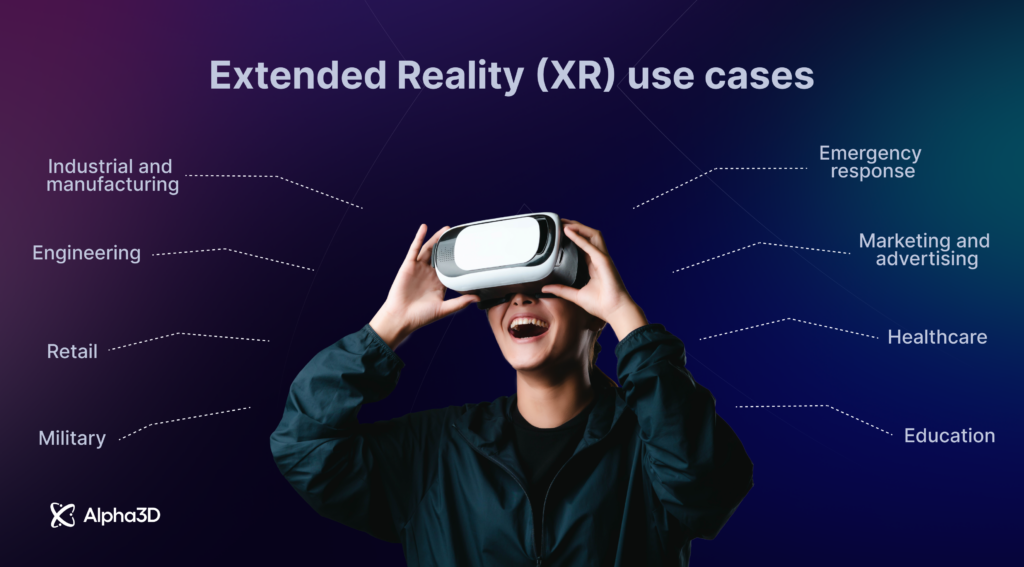
Real-world applications of immersive technologies
The transformative power of Extended Reality (XR) is not just confined to theoretical discussions; its impact is palpable across various industries, revolutionizing how we work, play, learn, and even heal.
XR in gaming: The gaming industry has been at the forefront of adopting and innovating with XR technologies. Games like Beat Saber and Half-Life: Alyx offer immersive experiences that transport players into intricately designed virtual worlds. These games leverage the full potential of XR, providing not just visual immersion but also haptic feedback and spatial audio, creating a holistic gaming experience.
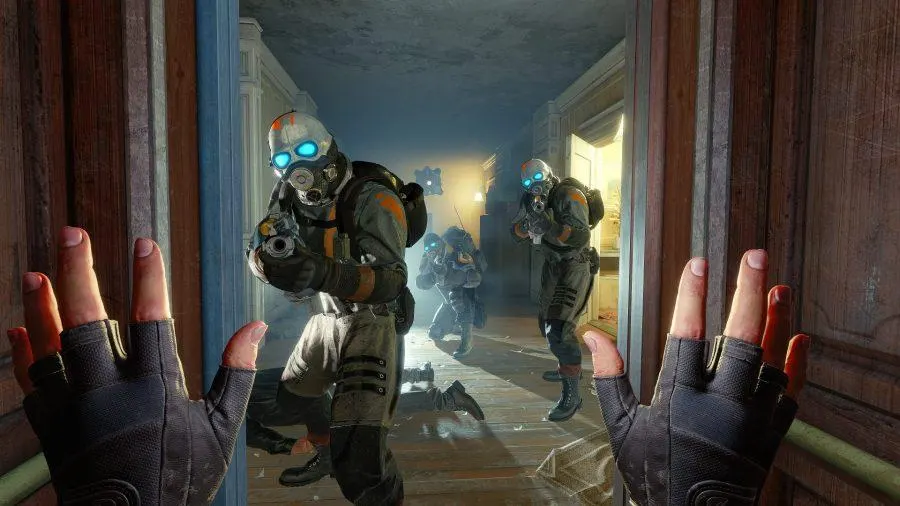 Image credit: Forbes
Image credit: Forbes
XR in healthcare: The healthcare sector is witnessing a paradigm shift with the integration of XR. Surgical simulations allow medical professionals to practice complex procedures in a risk-free environment. XR is also playing a pivotal role in rehabilitation, helping patients recover motor skills or cope with chronic pain through guided virtual exercises.
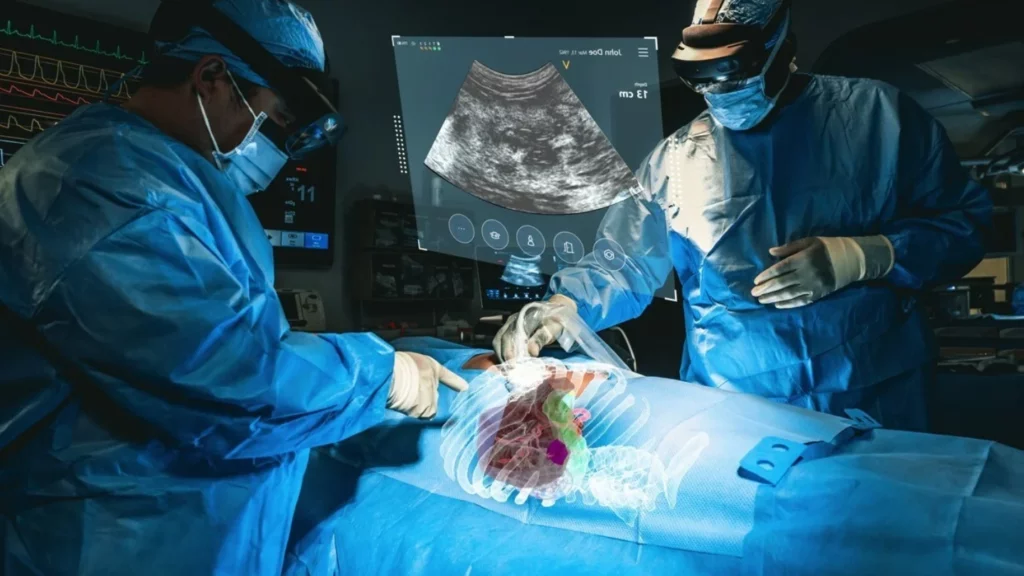 Image credit: MediView XR/PRNewswire
Image credit: MediView XR/PRNewswire
XR in retail: The retail landscape is being reshaped by XR, offering customers novel shopping experiences. Brands are leveraging virtual try-ons for apparel, eyewear, and even makeup. Augmented shopping experiences, where customers can visualize products in their real environment before purchasing, are becoming the norm, enhancing consumer confidence and reducing return rates.

XR in education: Education is undergoing a digital transformation, with XR playing a central role. Whether it’s virtual field trips that transport students to historical sites or interactive 3D models that make complex scientific concepts accessible, XR is enhancing learning by making it more engaging and experiential.
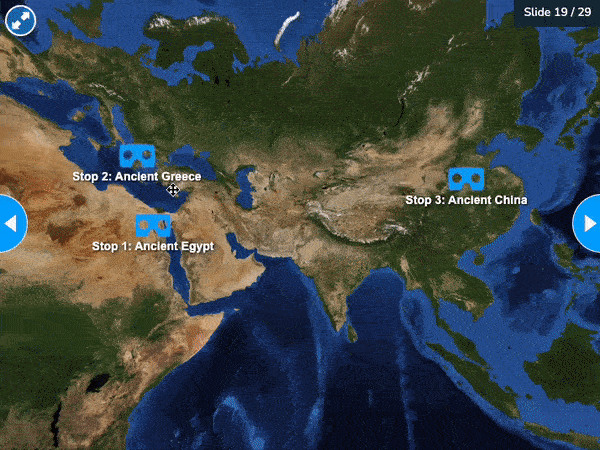
Conclusion
As we journey through the digital age, the lines between our physical reality and virtual realms continue to blur, thanks to the groundbreaking advancements in immersive technologies. From the augmentation of our real world with digital elements in AR, the complete immersion into virtual environments with VR, the dynamic blending of both in MR, to the all-encompassing spectrum of XR, each technology offers a unique perspective and set of possibilities.
The horizon for these technologies is vast and ever-expanding. As they become more integrated into our daily lives, industries from healthcare to education, retail to entertainment, will undergo transformative shifts. The potential of immersive technologies lies not just in their ability to create novel experiences but in their power to redefine how we learn, work, play, and connect. If you’re interested in exploring more on this, an interesting e-book was written by Cathy Hackl and Lily Snyder on how immersive wearable technologies can transform our daily lives in the future.
The future beckons with the promise of a world where our physical and digital realities are seamlessly intertwined, opening doors to experiences we’ve yet to imagine.
TL;DR FAQs
1. What is the main difference between AR and VR?
AR (Augmented Reality) overlays digital content onto the real world, enhancing our existing environment. In contrast, VR (Virtual Reality) immerses users in a completely virtual environment, detaching them from the real world.
2. How does MR differ from AR and VR?
MR (Mixed Reality) stands at the intersection of AR and VR. It blends elements from both, creating environments where digital and physical objects coexist and interact in real-time. Unlike AR, which simply overlays digital content, MR anchors virtual objects to the real world, allowing them to interact with their physical surroundings.
3. What does XR encompass?
XR (Extended Reality) is an umbrella term that captures the entire spectrum of experiences from the wholly real to the fully virtual. It includes AR, VR, MR, and any future immersive technologies.
4. Are there any health concerns associated with using VR?
While many users have positive experiences with VR, some might experience motion sickness or dizziness. It’s essential to take regular breaks, ensure the headset fits correctly, and start with shorter sessions to acclimate to the VR environment. Always consult with a healthcare professional if you have concerns.
5. Which industries are benefiting the most from immersive technologies?
Immersive technologies are making waves across various sectors. Healthcare is using VR for surgical training and patient rehabilitation, education is leveraging AR for interactive learning, the gaming industry is continually innovating with XR experiences, and retail is offering augmented shopping and virtual try-ons.
6. Are immersive technologies affordable for the average consumer?
The cost of immersive technologies has been decreasing over the years, making them more accessible to the average consumer. While high-end devices like the Microsoft HoloLens 2 might be on the pricier side, there are affordable VR headsets and AR apps available for smartphones.
7. What’s the future of immersive technologies?
The future of immersive technologies is promising, with continuous advancements and broader applications. As the technology becomes more refined and accessible, we can expect even more integration into our daily lives, transforming how we work, learn, and play.





